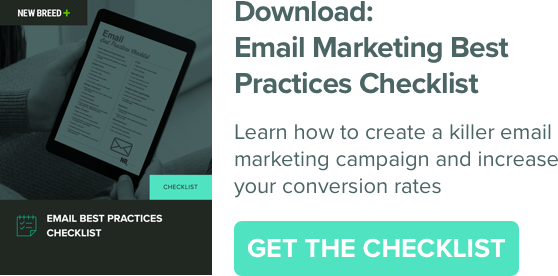 We're living in a digital world, this much has already been established. As someone who is constantly checking my iPhone, I can't imagine life without it. I'm always connected - whether it's checking my email, texting my friends, taking pictures and posting to social media, my phone is pretty much glued to my hand.
We're living in a digital world, this much has already been established. As someone who is constantly checking my iPhone, I can't imagine life without it. I'm always connected - whether it's checking my email, texting my friends, taking pictures and posting to social media, my phone is pretty much glued to my hand.
And I'm definitely not an anomaly.
Millions of people are smartphone users, meaning like me, they're equally as connected and probably checking their email 5+ times per day. So that means you should be in their inboxes, right?
Yes and no.
While, yes, email is still an important part of inbound marketing, with more and more companies leveraging these tactics, it's critical that we execute our campaigns correctly. Not only to get past the spam filters, but also to grab our customers' / prospects' attention.
Inboxes are crowded - sometimes very much so. I get over 100 emails per day in my personal email, and sometimes upward of 200 in my work inbox.
How do you break through that noise and stand out? We're not going to lie and say it's easy, but we do have a few tricks that will help you write email marketing that is engaging.
1) Trusted
Trust is one of the most important parts of your email marketing. If you don't have trust, then you'll never get into their inboxes. Focus on building trust from the very start - when someone is opting into your content, tell them what to expect. How often will they hear from you? What type of content will you be sharing with them?
But even more important than setting the expectations up front, you must keep your word. You can't say you're going to do one thing and then not follow through. This will break your recipient's trust and into the spam filter you go.
Setting expectations can do two things for you:
- They won't mark your email as spam, and you'll see more engagement.
- They will actually look forward to reading your content rather than just looking at it as another email in their inbox.
2) Always Relevant
When you're relevant, you're showing your readers that you know who they are - what they're interested in, what they care about and what they truly want to read.
But it isn't necessarily just about the content itself that can demonstrate how well you know your audience. You should also focus on being personal (personalizing the subject lines and greetings), where the reader truly feels like you are talking to them.
You should also work on your timing, which includes testing your send times and seeing what does the best. You can tell by your open rates and click through rates. Once you do this analysis, you'll have better visibility into their behavior and therefore be able to optimize your email sends to fit into those windows.
Basically, it comes down to this: if you're not sending relevant emails, your subscribers will opt-out.
3) Conversational
No one wants to feel like they're part of just one big email blast. You see when email marketing just started taking off, marketers basically just translated what they were doing offline (direct mail) into email. They blasted this information to as big of an audience as they could.
While that very may have been effective 5 years ago, the reality of where we are today, that kind of emailing won't get you anywhere. You need to be personal. You need to try and have a real and authentic conversation with your subscribers. Truthfully, it's what they're expecting.
The goal with your email is engagement, right? In this sense of the word, engagement is meant to start a two-way conversation. Your email isn't just talking to them, it's giving them the opportunity to respond and get involved.
4) Coordinated Across Channels
Consumers today are channel agnostic. By that we mean that they aren't committed to interacting with you in just one place, but rather they'll interact with you wherever is the most convenient for them - email, offline, social, your website, etc. - and from whatever device they have in their hand at the moment.
In fact, according to a survey conducted by Experian QAS®, 36% of U.S. organizations interact with customers and prospects in five or more channels every month.
What does that mean for you? That means you need to focus on delivering a seamless and integrated experience across all your platforms. From the emails you send, to the tweets you share, to your website, everything needs to work as one. When your email messages align with everything else you're producing, you will be able to continue to foster that relationship with your subscriber with ease.
5) Strategic
Now more than ever before, in order for your email marketing to be engaging, it needs to be strategic. When you think about traditional email marketing - the big blasts - while the marketers might think they're being strategic, they're not.
And to be more strategic, we need metrics. A study conducted by Marketo found that top performers in email marketing spent 22% of their time on email strategy vs. the 14% average.
When you're sending out emails, it is essential that you track your efforts and refine them as you go. You need to pay attention to traditional metrics like open rates, click rates, bounce rates, unsubscribe rates, etc., but also think about ROI and other engagement metrics.
And after everything, just remember, you want to focus on your subscriber. Always keep them and their needs in mind before you hit that send button.





